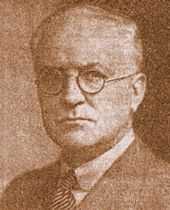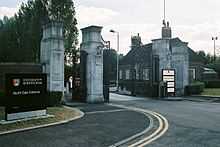William Haywood (architect)

William Joseph Haywood (1876–1957) was an English architect and Secretary of The Birmingham Civic Society for over thirty years, being a founder member in 1918.
Life
Born on 2 November 1876 in Ingleby Street, Ladywood, Birmingham, he was the son of Joseph Haywood, a local Silversmith, and Emma Haywood (née Ferres). He had been a brilliant student who won the Maintenance Scholarship of Birmingham School of Art in 1894, the Pugin Studentship in 1897 and the RIBA Silver Medal.
From 1900, he was a practising architect and also designed in stained glass, wrought iron and cast lead. In 1914, he went into partnership with Herbert Tudor Buckland, who would later join Haywood on the Executive Council of The Birmingham Civic Society. The partnership of Buckland-Farmer operated from offices in Norwich Union Chambers, Corngreve Street (now demolished).

Haywood produced many schemes for replanning the city, and published his ideas in The Development of Birmingham (1918), which included improvements to New Street Station, a grand "People’s Hall" located close to where the Central Fire Station now stands, pleasure grounds and Zoological Gardens around Edgbaston Reservoir and various grand approaches to the major civic buildings in the city. The Dome Room at the Birmingham Museum & Art Gallery presents one of the grand ambitions that Haywood had for Birmingham; The Civic Centre which incorporated Baskerville House as but a small fraction of the civic building complex in Broad Street. As a result of his book, Sir Oliver Lodge invited him to take the University Special Lectureship on Town Planning, which he held for 25 years.

He designed the memorial in Cannon Hill Park to Scouts who fell in the first and (by later inscription) second world wars. It is in concrete, and was unveiled on 27 July 1924.
Buckland & Haywood specialised in school work, and St Hugh's College, Oxford (1914–16)[1] gained them a national reputation.[citation needed] Their largest work in this field is the Royal Hospital School, Holbrook, Suffolk (1925–33), which includes a chapel. The entrance to the University of Birmingham in Pritchatt’s Road was also a design of Haywood’s.

Haywood’s other commercial work includes the new entrance and offices for the Soho Foundry, Smethwick (1928), and the entrance lodges and offices for Kynochs (IMI plc) in Wellhead Lane, Perry Barr.
However, perhaps one of the most widely popular of his endeavours was the city-wide decorations for the coronation of King George VI and Queen Elizabeth and centenary of the Charter of Birmingham the following year in 1938. Haywood did the city proud as Executive of the Schemes of Decoration. Professor Thomas Bodkin (First Director of the Barber Institute of Fine Arts) wrote in 1937 that "the decorations of the municipal buildings and the principal streets of the city were considered to be the best of their kind in England". They included heraldic shields and banners of the Lords of the Manor of Birmingham from 1166 onwards, which decorated the Council House and Town Hall; models of Britannia for the tympana of the Town Hall; a column of St George in Victoria Square which rose above the statues of Queen Victoria and Edward VII. There were various other banners celebrating the Coronation, our ancient kingdom, the Union and of the countries of the Commonwealth. There was even the implementation of a scheme that involved lighting up the public buildings and parks around the city.

Many of William Haywood’s dreams may not have come to fruition, but the current plans for the re-design of New Street Station incorporate a large central hall, lit by natural light from above and combine this with a large grand entrance from Hill Street which is very similar to the plans Haywood produced in 1918.
Haywood lived at 245 Bristol Road, Edgbaston, from 1915 to his death in 1957, which is just past the junction with Priory Road going out of the city. His house was demolished in the 1970s, so that the land could be used as part of the Jacoby Place residential development. However, the brick and stone gate piers remain – and they are remarkably similar, albeit smaller, to the gate piers of the Pritchatt’s Road entrance to the University.
William Haywood died on his 81st birthday, 2 November 1957 from a cerebral haemorrhage in Selly Oak Hospital, Birmingham.
Publications
- Haywood, William, "Pugin Travelling Studentship Report" to the RIBA on study tour of mediaeval architecture in North Wiltshire and Somerset 1897
- Haywood, William, "The Development of Birmingham", 1918
- Haywood, William, "The Work of The Birmingham Civic Society 1918–34", 1934
- Haywood, William, "The Work of The Birmingham Civic Society 1918–46", 1946
References
- ↑ Sherwood, Jennifer; Pevsner, Nikolaus (1974). The Buildings of England: Oxfordshire. Penguin Books. pp. 247–248. ISBN 0-14-071045-0.
Further reading
- Foster, Andy, Pevsner Architectural Guide — Birmingham, pp 26, 31, 144, 197, 242. ISBN 0-300-10731-5.
External links
|